When it comes to crafting the perfect ambiance in your home, few things are as influential as the paint colors you choose. The colors adorning your walls have the remarkable ability to shape your perception of a room, creating an atmosphere that resonates with your personality and style. In this article, we delve into the transformative power of dark paint colors in small rooms, specifically focusing on their impact in smaller spaces.
The Psychology Behind Dark Colors
Evoking Emotions
Delving into the psychology of color, it’s fascinating to discover how dark hues can evoke a spectrum of emotions. Unlike their lighter counterparts, dark colors often exude a sense of mystery, drama, and even sophistication. They have the unique ability to create an atmosphere that goes beyond mere aesthetics, tapping into the emotional core of a space.
Cozy and Intimate Vibes
One of the most enchanting aspects of dark colors is their ability to infuse a room with a cozy and intimate feel. Imagine a small living room painted in a deep, rich hue—suddenly, the space becomes a warm cocoon, inviting you to unwind and relax. It’s this transformative quality that makes dark paint colors a game-changer for smaller rooms.
Choosing the Right Dark Paint Color
Consideration of Room Size and Natural Light
Before diving into the world of dark paint colors, it’s crucial to consider the size of the room and the amount of natural light it receives. While dark hues can undoubtedly add depth and character, they may also make a small room feel more enclosed. Balancing this with strategic lighting and the right color choice is key to achieving the desired effect.
Popular Dark Color Options and Their Unique Effects
Charcoal Gray: Creating Depth and Sophistication
Charcoal gray stands out as a versatile choice, adding depth and a touch of sophistication to any small space. Its neutral undertones make it an excellent canvas for pairing with vibrant accents, allowing you to personalize the room while maintaining a sense of elegance.
Navy Blue: Enhancing a Sense of Calm and Serenity
Navy blue, with its calming undertones, is perfect for creating a serene atmosphere in a small room. This color choice works wonders in bedrooms and cozy reading nooks, enveloping the space in tranquility and timeless style.
Forest Green: Bringing Nature Indoors
For those who crave a connection to nature, forest green is an ideal dark paint color. Transform your small room into a woodland retreat, with the deep green tones promoting a sense of harmony and bringing the outdoors inside.
The transformative potential of dark paint colors in small rooms is a design secret worth exploring. By understanding the psychology behind these hues and carefully selecting the right shade for your space, you can turn a modest room into a captivating haven of style and emotion. Embrace the dark side and let your home’s personality shine.
Addressing Common Concerns
Myth-Busting: Dispelling Misconceptions About Dark Colors in Small Spaces
Dark paint colors in small rooms often face unwarranted skepticism. Let’s debunk some common myths to reveal the true potential of embracing the darker side of the color palette.
Myth 1: Dark Colors Make Rooms Feel Smaller
Contrary to popular belief, dark colors don’t necessarily shrink a space. When used thoughtfully, they can enhance the room’s character and create a cozy, inviting atmosphere.
Myth 2: Dark Colors Lack Versatility
Dark colors are remarkably versatile. They provide a sophisticated backdrop for various design elements and can be paired with a wide range of furnishings and decor styles.
Myth 3: Limited Light Means No Dark Colors
While natural light is a consideration, a well-lit room can benefit from dark hues. Strategic lighting and the right color choice can work together to illuminate and amplify the space.
Tips for Overcoming the Fear of Making a Room Feel Smaller
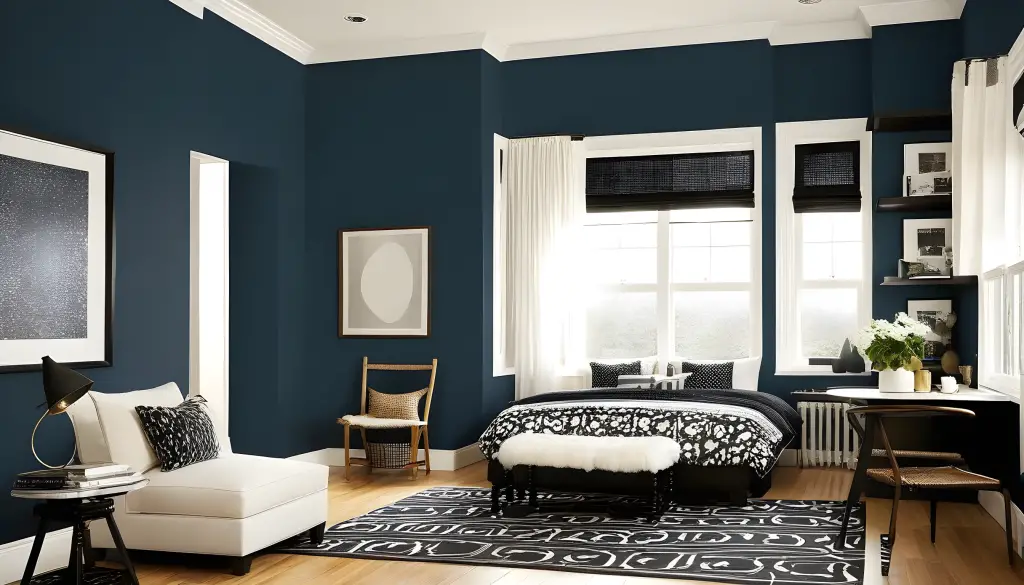
Feeling apprehensive about making a small room feel even more confined with dark paint? Fear not; here are some tips to navigate and conquer that fear.
Tip 1: Embrace Contrast
Pair dark walls with lighter furnishings and decor to create a visual contrast that opens up the space.
Tip 2: Opt for Glossy Finishes
Choose glossy finishes for dark colors; they reflect light and add a subtle sheen, contributing to a more spacious feel.
Tip 3: Strategic Lighting
Illuminate your space strategically. Incorporate a mix of ambient, task, and accent lighting to counteract any potential darkness.
Benefits of Using Dark Paint Colors
Illusion of Depth: Making Small Rooms Appear Larger
One of the remarkable benefits of using dark paint colors is the illusion of depth they create. When applied strategically, these colors draw the eye, making the walls recede and giving the impression of a larger space. It’s a clever optical trick that transforms the perceived dimensions of your room.
Accentuating Architectural Features with Strategic Color Placement
Dark colors can be wielded like a painter’s brush, emphasizing the unique architectural features of a room. Whether it’s molding, trim, or a distinctive alcove, the judicious use of dark hues draws attention to these details, elevating the overall aesthetic.
Showcasing Furniture and Decor Against a Dramatic Backdrop
Imagine your furniture and decor against a dramatic, dark backdrop. Dark walls serve as a canvas, allowing your furnishings to take center stage. Vibrant colors pop against the darkness, creating a captivating visual contrast that adds flair to your small space.
The benefits of using dark paint colors in small rooms far outweigh the misconceptions. By dispelling myths and embracing strategic design principles, you can harness the transformative power of dark hues, turning your small space into a design masterpiece. So, don’t be afraid to explore the rich and alluring world of dark paint colors for a home that truly stands out.
Step-by-Step Guide to Painting a Small Room Dark
Preparing the Room: Cleaning, Patching, and Priming
Before diving into the transformative process of painting a small room dark, it’s crucial to prepare the canvas. Follow these steps:
- Clean Thoroughly: Remove dust, dirt, and any cobwebs from the walls. A clean surface ensures better adhesion to the paint.
- Patch Imperfections: Address any holes, cracks, or imperfections with a quality patching compound. Smooth out the patched areas for a seamless finish.
- Prime the Surface: Apply a high-quality primer to create a smooth and uniform base for the dark paint. Primer enhances adhesion and promotes an even color outcome.
Choosing the Right Tools and Paint Type
Selecting the appropriate tools and paint type is pivotal for a successful painting project:
- Tools: Invest in quality paintbrushes, rollers, painter’s tape, and drop cloths. These tools will contribute to a professional finish and minimize mess.
- Paint Type: Choose a high-quality paint with a durable finish. Satin or eggshell finishes are often recommended for walls, as they strike a balance between easy cleaning and an appealing aesthetic.
- Painting Techniques for an Even and Professional Finish
Mastering the right techniques ensures a flawless application of dark paint:
- Cutting In: Start by cutting in around the edges of the walls and corners using a high-quality angled brush. This creates clean lines and edges.
- Rolling: Use a roller for the main wall surfaces. Roll in a “W” or “M” pattern to evenly distribute the paint and avoid streaks.
- Multiple Coats: Dark colors may require multiple coats for full coverage. Allow each coat to dry completely before applying the next.
Combining Dark Colors with Other Elements
Selecting Complementary Furniture and Decor
Harmonizing dark walls with furniture and decor is key to achieving a cohesive look:
- Contrast and Complement: Choose furniture in lighter shades to create contrast against the dark walls. Wood tones and metallic finishes can add warmth and sophistication.
- Texture Play: Introduce textured fabrics and materials to prevent a monotone look. Plush rugs, throw pillows, and varied textures add depth to the space.
Tips for Incorporating Pops of Color to Avoid Monotony
Avoid a monochromatic feel by infusing pops of color strategically:
- Accent Pieces: Introduce vibrant accent pieces like artwork, cushions, or a statement piece of furniture to break up the dark color scheme.
- Greenery: Plants bring life to any room. Consider adding indoor plants to infuse your home with a refreshing burst of color.
- Integrating Lighting to Enhance the Dark Color Scheme
Thoughtful lighting can enhance the beauty of dark walls:
- Ambient Lighting: Install ambient lighting sources to evenly illuminate the room. This helps prevent a cave-like feel and showcases the dark color in its full glory.
- Task Lighting: Incorporate task lighting where needed, such as reading lamps or under-cabinet lights. This adds functionality while contributing to the overall ambiance.
Maintenance and Longevity
Tips for Preserving the Vibrancy of Dark Paint Colors
To ensure your dark-painted small room retains its allure over time, follow these maintenance tips:
- Regular Cleaning: Dust and gently clean the walls regularly to prevent buildup. Use a soft cloth or sponge to avoid damaging the paint.
- Avoid Harsh Cleaning Agents: Stick to mild cleaning solutions to protect the paint finish. Harsh chemicals can dull the vibrancy of dark colors.
Cleaning and Touch-Up Strategies for Lasting Appeal
Maintaining the longevity of a dark-painted room requires a combination of regular cleaning practices and strategic touch-up strategies. Here are some key considerations to ensure lasting appeal for your dark-colored walls:
Regular Dusting:
- Strategy: Dust accumulation is more noticeable on dark surfaces. Regularly dust walls using a soft, lint-free cloth or a microfiber duster. This prevents the buildup of particles that can dull the vibrancy of dark colors over time.
Gentle Cleaning Solutions:
- Strategy: When cleaning dark walls, opt for mild cleaning solutions to avoid damaging the paint. Mix a small amount of gentle dish soap with water or use a specialized wall-cleaning solution. Avoid abrasive cleaners that may scratch or wear down the paint.
Spot Cleaning:
- Strategy: Address stains and marks promptly with spot cleaning. Dampen a clean cloth with the chosen cleaning solution and gently blot the affected area. Avoid excessive rubbing to prevent color fading or damage.
Avoid Harsh Chemicals:
- Strategy: Harsh chemicals, including bleach and strong cleaning agents, can damage dark paint. Stick to mild, pH-neutral cleaning solutions to preserve the integrity of the color and finish. Always test any cleaning product in an inconspicuous area before widespread use.
Protect High-Traffic Areas:
- Strategy: High-traffic areas are prone to scuffs and marks. Protect these areas by strategically placing furniture, rugs, or decor items that can act as buffers. This preventive measure minimizes the impact of daily wear and tear.
Use Soft Brushes for Textured Walls:
- Strategy: If your dark-painted walls have texture, use soft brushes or vacuum attachments to remove dust and cobwebs. Be gentle to avoid damaging the texture while maintaining the cleanliness of the walls.
Touch-Up Paint:
- Strategy: Regularly inspect your walls for scuffs, scratches, or areas where the paint may have worn off. Keep a small amount of touch-up paint in the original color for quick fixes. This helps maintain a consistent appearance and prevents visible signs of wear.
Lighting Considerations:
- Strategy: Proper lighting can enhance the longevity of dark paint colors. Ensure adequate lighting in the room to prevent shadows that may highlight imperfections. Well-lit spaces also contribute to a vibrant and appealing atmosphere.
Prevent Water Damage:
- Strategy: Dark-painted walls are susceptible to water damage. Be cautious in areas prone to moisture, such as bathrooms and kitchens. Use exhaust fans or ventilation to reduce humidity, preventing issues like mold and mildew that can affect the paint.
Protect Corners and Edges:
- Strategy: Corners and edges are more prone to nicks and chips. Install corner guards or be mindful when moving furniture to prevent collisions with the walls. This proactive approach protects vulnerable areas from damage.
Regular Inspections:
- Strategy: Conduct regular inspections of your dark-painted walls. Look for any signs of wear, discoloration, or damage. Addressing issues promptly ensures that the walls maintain their allure and appeal over an extended period.
By incorporating these cleaning and touch-up strategies, you can preserve the vibrancy and appeal of your dark-painted room, ensuring that it continues to be a stylish and inviting space for years to come. Regular care and attention contribute significantly to the longevity of dark colors in your living environment.
Realizing the Potential: Small Rooms Transformed
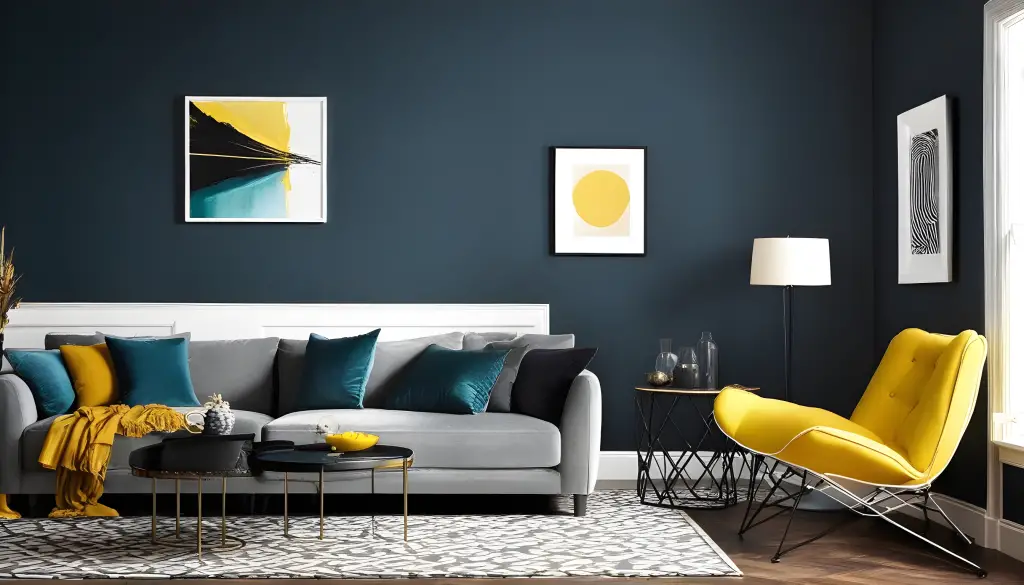
Showcasing Stunning Examples of Small Rooms with Dark Color Makeovers
Cozy Reading Nook with Charcoal Gray Walls:
- Description: Imagine a small reading nook with walls painted in a deep charcoal gray. The dark color wraps the space in a cozy embrace, making it an intimate haven for reading. Lighter-toned, plush armchairs and a reading lamp create a perfect contrast against the dark walls, emphasizing the comfort and sophistication of the space.
Elegant Dining Area in Midnight Blue:
- Description: Picture a compact dining area adorned with midnight blue walls. The dark, velvety hue adds a touch of elegance to the space, making it a stylish setting for intimate dinners. A well-lit chandelier above the dining table creates a beautiful interplay of light and shadow, enhancing the sophistication brought out by the deep blue walls.
Nature-Inspired Bedroom in Forest Green:
- Description: Visualize a small bedroom transformed with forest green walls. The deep, natural hue brings the essence of the outdoors inside, creating a tranquil and inviting atmosphere. Light-colored bedding and natural wood furnishings complement the dark walls, showcasing the versatility of the forest green palette.
Intimate Home Office with Aubergine Walls:
- Description: Envision a compact home office with walls painted in a luxurious aubergine (dark purple). The richness of the color adds a sense of opulence to the space, creating an environment conducive to focus and creativity. Light-colored furniture and strategic lighting enhance the stylish and welcoming ambiance.
Sophisticated Living Room in Navy Blue:
- Description: Picture a small living room adorned with navy blue walls. The deep, sophisticated hue sets the stage for a stylish and welcoming gathering space. A mix of plush, textured throw pillows on a neutral-colored sofa adds layers of comfort, while metallic accents and artwork pop against the dark backdrop.
Luxurious Bathroom in Deep Burgundy:
- Description: Imagine a compact bathroom with walls painted in a deep burgundy. The dark, velvety color transforms the space into a luxurious retreat. A combination of gold fixtures, a statement mirror, and soft lighting enhances the opulence brought out by the dark burgundy walls.
Modern Kitchen with Slate Blue Accents:
- Description: Visualize a modern kitchen featuring slate blue accent walls. The cool, muted tones of slate blue create a contemporary and welcoming atmosphere. Stainless steel appliances and light-colored cabinetry provide a striking contrast, highlighting the sleek and stylish elements of the kitchen.
Chic Entryway in Deep Teal:
- Description: Picture a chic entryway with walls painted in a deep teal hue. The dark color sets a bold and welcoming tone as soon as you step inside. A strategically placed mirror reflects light and adds an element of spaciousness, demonstrating how dark colors can be both stylish and practical in a small entryway.
Highlighting the Positive Impact on Overall Ambiance
Dark colors, often underestimated in small spaces, can remarkably contribute to creating a welcoming and stylish ambiance when used thoughtfully. Here are some insights into how dark colors achieve this effect:
Intimacy and Coziness:
- Dark colors have the innate ability to envelop a space in warmth, creating a cozy and intimate atmosphere. In small rooms, this quality becomes especially pronounced, as the walls seem to embrace and cocoon the space, making it feel inviting and comforting.
Visual Depth and Dimension:
- Dark colors, contrary to the misconception that they make a space feel smaller, can add visual depth and dimension. The shadows created by dark walls give the illusion of layers, making the room feel more intricate and interesting. This effect is particularly advantageous in small spaces where the goal is to avoid a flat, one-dimensional look.
Sophistication and Elegance:
- Dark colors inherently exude sophistication and elegance. When applied to the walls of a small room, they elevate the overall aesthetic, creating a sense of refinement. The richness of dark hues adds a touch of luxury, turning even the most modest spaces into stylish retreats.
Accentuation of Architectural Features:
- Dark colors can be strategic allies in highlighting architectural features. In small rooms, where every detail matters, dark walls serve as a canvas that emphasizes molding, trim, and other architectural elements. This accentuation adds character and visual interest to the space.
Showcasing Furnishings and Decor:
- Dark walls act as a dramatic backdrop that allows furnishings and decor to take center stage. In a small room, where every piece contributes significantly to the overall ambiance, the contrast between dark walls and lighter-colored furniture or vibrant accessories creates a striking visual impact.
Mood Enhancement:
- The choice of color inherently influences mood, and dark colors are no exception. Rich, deep hues have the power to evoke specific emotions, and in small spaces, they can create a mood of tranquility and sophistication. This intentional mood enhancement contributes to a welcoming atmosphere.
Versatility in Styling:
- Dark colors are remarkably versatile when it comes to styling. They provide a neutral yet distinctive backdrop that can accommodate various decor styles. Whether you prefer a minimalist aesthetic or a more eclectic look, dark walls serve as a versatile foundation that adapts to different design preferences.
Mitigation of Clutter:
- Dark colors have a unique ability to downplay visual clutter. In a small space where storage challenges may be present, dark walls can minimize the perception of clutter by drawing the eye away from minor details, creating a more streamlined and organized appearance.
Timelessness and Enduring Appeal:
- Dark colors, when chosen wisely, possess a timeless quality that withstands trends. This enduring appeal ensures that the welcoming and stylish ambiance created in a small space remains relevant and attractive over time, providing a lasting sense of satisfaction.
Strategic Lighting Enhancement:
- Dark walls offer an opportunity for strategic lighting enhancement. Well-placed lighting fixtures, including wall sconces, pendant lights, or strategically positioned lamps, can create pockets of illumination that further enhance the welcoming and stylish feel of the space.
The use of dark colors in small spaces contributes to a welcoming and stylish ambiance by leveraging their inherent qualities of warmth, sophistication, and versatility. When approached with careful consideration of lighting, contrast, and decor choices, dark colors can transform a small room into a haven that not only welcomes but also captivates with its stylish allure.
Trend Alert: Dark Color Combinations
Exploring Popular Color Palettes and Combinations
Exploring popular color palettes and combinations is a delightful journey into the world of design, where the right blend of hues can evoke specific moods and create visually captivating spaces. Whether you’re planning a room makeover or seeking inspiration for a fresh color scheme, here are some popular color palettes and combinations to consider:
Monochromatic Elegance:
- Palette: Various shades of a single color.
- Combination: Deep navy walls paired with lighter navy furnishings and decor.
- Effect: Monochromatic palettes create a sense of harmony and sophistication. The variations in shades add depth without overwhelming the space.
Bold Contrasts:
- Palette: High-contrast combinations like black and white or navy and gold.
- Combination: Charcoal gray walls with crisp white trim and furnishings.
- Effect: Bold contrasts make a strong statement, creating a dynamic and visually striking atmosphere. This combination is timeless and adds a touch of modern elegance.
Nature-Inspired Hues:
- Palette: Earthy tones such as forest green, terracotta, and deep brown.
- Combination: Forest green accent wall paired with wooden furniture and earth-toned accessories.
- Effect: Nature-inspired palettes bring a sense of calm and connection to the outdoors. Deep greens and browns create a cozy, grounded atmosphere.
Muted Pastels:
- Palette: Soft, muted pastel shades like dusty rose, sage green, and muted blue.
- Combination: Muted blue walls with blush pink and sage green accents.
- Effect: Muted pastels offer a gentle, soothing vibe. This palette is perfect for creating serene spaces, especially in bedrooms or reading nooks.
Vintage Vibes:
- Palette: Retro-inspired colors like mustard yellow, burnt orange, and avocado green.
- Combination: Mustard yellow accent wall paired with mid-century modern furniture.
- Effect: Vintage-inspired palettes evoke a sense of nostalgia and playfulness. Bold, warm colors create a cozy and inviting atmosphere with a touch of retro flair.
Dramatic Jewel Tones:
- Palette: Rich, deep jewel tones like emerald green, sapphire blue, and amethyst purple.
- Combination: Deep purple walls complemented by emerald green and sapphire blue accents.
- Effect: Jewel tones add opulence and drama to a space. This palette is ideal for those who want to make a bold and luxurious statement.
Urban Industrial:
- Palette: Cool, industrial tones like gray, steel blue, and concrete.
- Combination: Gray walls paired with steel blue accents and concrete-inspired furnishings.
- Effect: Urban industrial palettes create a modern, edgy aesthetic. The cool tones and textures evoke a sense of contemporary urban living.
Coastal Serenity:
- Palette: Soft blues, sandy beige, and crisp white.
- Combination: Soft blue walls with white trim, complemented by beige and blue furnishings.
- Effect: Coastal palettes bring a sense of tranquility and freshness. These colors are reminiscent of the sea and sky, creating a light and airy atmosphere.
Timeless Neutrals:
- Palette: Classic neutrals like beige, taupe, and ivory.
- Combination: Taupe walls with beige and ivory furnishings.
- Effect: Timeless neutrals provide a versatile and enduring backdrop. This palette is perfect for creating a calm and timeless look that can easily adapt to changing decor styles.
Sunset-Inspired Warmth:
- Palette: Warm tones inspired by a sunset, such as burnt orange, deep red, and golden yellow.
- Combination: Burnt orange accent wall with deep red and golden yellow accents.
- Effect: Sunset-inspired palettes infuse warmth and vibrancy into a space. These colors create a cozy and inviting atmosphere, especially in living rooms or dining areas.
Popular dark color combinations with visual examples to inspire your next design endeavor:
Navy Blue and Gold:
- Visual Example: Deep navy blue walls complemented by gold accents, such as a gold-framed mirror and metallic gold accessories. The richness of navy paired with the warmth of gold creates a luxurious and sophisticated atmosphere.
Charcoal Gray and Blush Pink:
- Visual Example: Charcoal gray walls paired with blush pink furnishings, throw pillows, and artwork. This combination strikes a perfect balance between the deep, moody tones of charcoal and the soft, romantic hues of blush pink.
Forest Green and Brass:
- Visual Example: A room with forest green accent walls adorned with brass fixtures and furniture. The deep, natural green tones complement the warm, metallic sheen of brass, creating an elegant and inviting space.
Deep Burgundy and Beige:
- Visual Example: Deep burgundy walls paired with beige furnishings and light-colored accessories. This combination exudes warmth and sophistication, creating a cozy and inviting ambiance.
Eggplant Purple and Silver:
- Visual Example: Eggplant purple walls enhanced by silver accents, such as silver-framed mirrors and metallic silver decor. This pairing brings a touch of glamour and modernity to the room.
Slate Blue and Copper:
- Visual Example: Slate blue walls complemented by copper-toned light fixtures, vases, and decor. The cool tones of slate blue harmonize with the warm, earthy tones of copper, creating a balanced and visually appealing space.
Chocolate Brown and Cream:
- Visual Example: Chocolate brown walls paired with cream-colored furnishings and accents. This classic combination creates a sense of timeless elegance and warmth.
Midnight Black and White:
- Visual Example: A room with midnight black walls contrasted by crisp white trim and furnishings. This high-contrast combination exudes modernity and sophistication.
Deep Teal and Mustard Yellow:
- Visual Example: Deep teal walls paired with mustard yellow accents in furniture and decor. This vibrant and unexpected pairing adds energy and personality to the space.
Aubergine and Silver:
- Visual Example: Aubergine (dark purple) walls complemented by silver-toned accessories and furnishings. This regal combination creates a luxurious and refined atmosphere.
These visual examples showcase the versatility and beauty of dark color combinations. Whether you prefer the timeless elegance of navy and gold or the bold contrast of black and white, these pairings can serve as inspiration for transforming your living space into a visually stunning and harmonious haven.
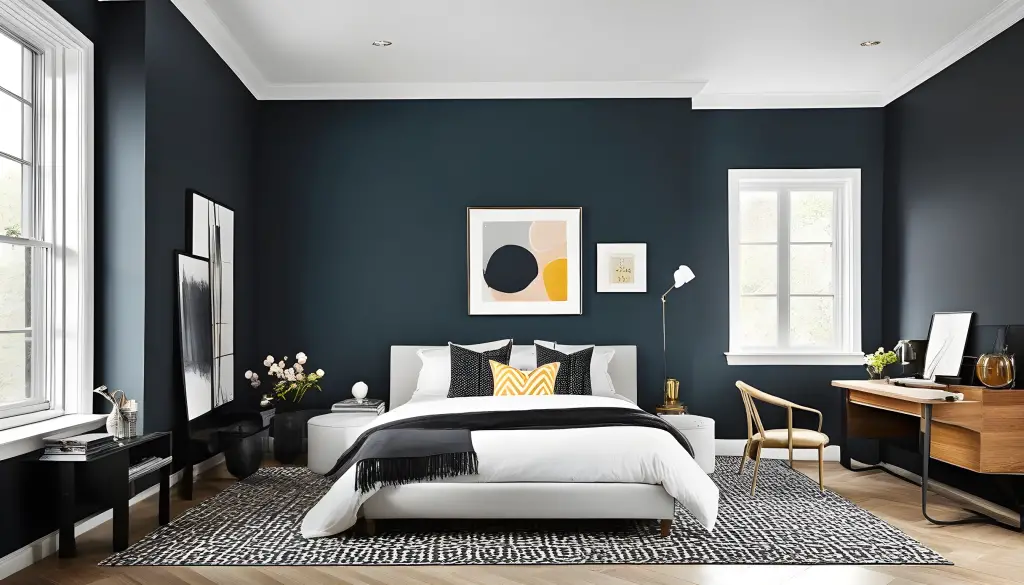
Tips for Experimenting with Dark Color Trends
Experimenting with dark color trends can be an exciting venture, adding depth, drama, and personality to your living spaces. Whether you’re considering a bold accent wall or an entire room makeover, here are some tips to help you navigate and embrace the allure of dark color trends:
Start Small:
- If you’re new to dark colors, start with smaller elements like accent furniture, throw pillows, or decor items. This allows you to gauge your comfort level with the intensity of the hue without committing to a large-scale change.
Focus on Lighting:
- Dark colors can dramatically transform based on lighting conditions. Experiment with different lighting sources, including natural light, to see how the color behaves throughout the day. Consider warm and cool-toned lighting to find the optimal ambiance for your chosen dark hue.
Consider Undertones:
- Dark colors often come with various undertones that can influence the overall mood of a room. Pay attention to whether the color has warm or cool undertones and how they interact with other elements in your space. This consideration ensures a cohesive and harmonious look.
Create Contrast:
- To prevent a space from feeling too heavy, incorporate elements of contrast. Pair dark walls with lighter furniture, trim, or accessories to create visual balance. This interplay adds interest and prevents the room from feeling overly monochromatic.
Test Paint Samples:
- Before committing to a full room makeover, test paint samples on different walls. Colors can appear different under various lighting conditions, and testing allows you to see how the chosen hue interacts with your specific space.
Use Dark Colors for Focus:
- Dark colors draw attention, making them ideal for creating focal points in a room. Consider using a dark hue for an accent wall or on architectural features like alcoves or built-in shelves. This technique adds depth without overwhelming the entire space.
Pair with Complementary Colors:
- Explore color wheels and complementary color schemes to find shades that work harmoniously with your chosen dark color. Complementary colors can be introduced through furnishings, decor, or even accent pieces, providing a well-rounded and aesthetically pleasing look.
Integrate Patterns and Textures:
- Break up the solidity of dark walls by incorporating patterns and textures. Consider wallpapers, textured paints, or even wall decals to add visual interest. This layering of elements adds depth and complexity to the design.
Balance with Light Furniture:
- Dark colors tend to make a room feel cozy, but pairing them with heavy, dark furniture can create a somber atmosphere. Opt for lighter-colored furniture to balance the richness of the walls and maintain an airy feel.
Go Bold with Accessories:
- If committing to dark walls feels too daunting, experiment with dark accessories. Incorporate bold, dark-colored rugs, curtains, or statement furniture pieces to add a touch of drama without overwhelming the entire space.
Consider the Room’s Purpose:
- Think about the function of the room when selecting dark colors. Deep blues and greens can create a serene atmosphere in bedrooms, while rich reds or purples might be well-suited for a cozy living room. Tailor your color choice to the intended mood of the space.
Embrace Accent Lighting:
- Use accent lighting strategically to highlight specific areas or features. This not only enhances the overall ambiance but also adds a layer of sophistication to the dark color scheme.
Remember, the key to successfully experimenting with dark color trends is finding a balance that suits your taste and complements your overall design vision. Whether you opt for a subtle introduction of dark hues or go for a bold, dramatic transformation, let your creativity guide you as you explore the world of rich and alluring colors.
Conclusion
In interior design, the transformative power of dark paint colors for small rooms cannot be overstated. Throughout this journey, we’ve explored the psychology behind these hues, and busted myths, and provided a comprehensive guide on painting small rooms in rich, deep tones. From the illusion of depth to accentuating architectural features, the benefits of embracing the dark side are abundant.
We’ve witnessed stunning examples of small rooms that have undergone remarkable makeovers, showcasing how dark colors can turn modest spaces into captivating sanctuaries. The positive impact on the overall ambiance is undeniable, as dark hues create an intimate and sophisticated atmosphere, dispelling common misconceptions along the way.
As we conclude, we extend a warm invitation to our readers. The transformative journey of small room makeovers with dark paint colors is not just a design choice; it’s an expression of personality, style, and a love for spaces that resonate with your being. Don’t shy away from the allure of deep, rich tones; instead, embrace the potential they hold to turn your small room into a haven of comfort and style.
Whether you’re seeking the advice of experts, exploring the latest trends, or contemplating DIY projects, remember that the canvas of your home is yours to paint. Let your creativity flow, and embark on your small room makeover journey with the confidence that comes from understanding the nuances of dark paint colors.
In the world of design, the possibilities are as endless as your imagination. So, go ahead – pick up that paintbrush, choose your favorite dark hue, and watch as your small room transforms into a space that reflects the beauty of your unique vision. Happy decorating!
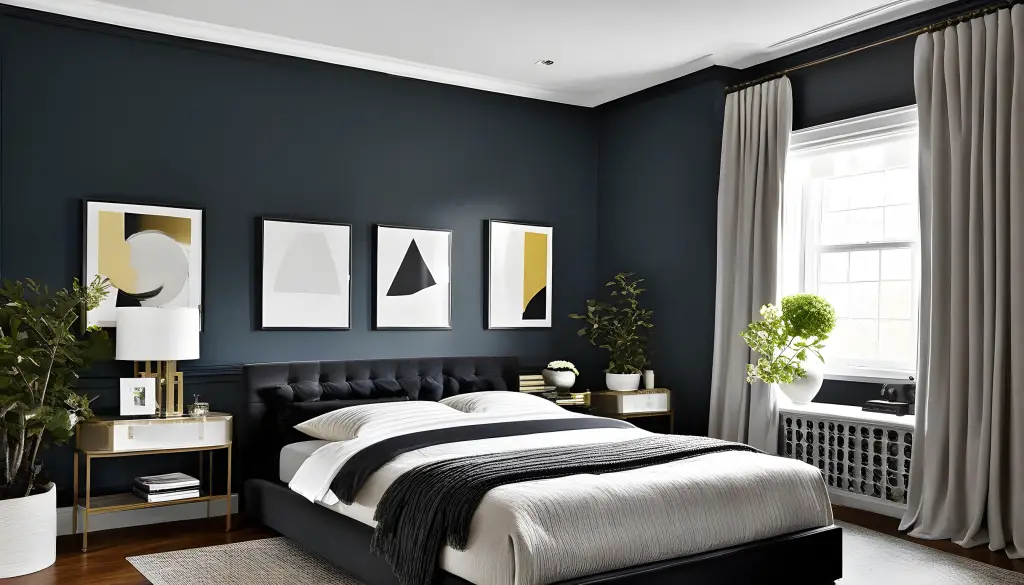








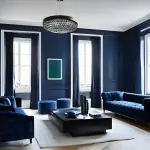
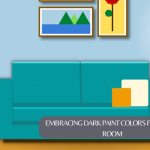
Pingback: How Do You Organize A Corner Space? - Pantry Raider
Pingback: Who Makes The Best Storage Cabinet? A Comprehensive Guide - Pantry Raider